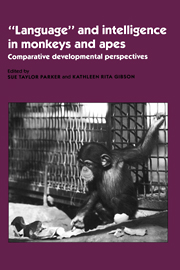Book contents
- Frontmatter
- Contents
- List of contributors
- Foreword
- Preface
- Acknowledgments
- Part I Theoretical frameworks for comparative developmental studies
- Part II Comparative developmental perspectives on cebus intelligence
- 5 The comparative study of cognitive ontogeny in four primate species
- 6 Sensorimotor development in hand-reared and mother-reared tufted capuchins: A systems perspective on the contrasts
- 7 Tool use, imitation, and deception in a captive cebus monkey
- 8 The role of innate motor patterns in ontogenetic and experiential development of intelligent use of sticks in cebus monkeys
- Part III Questions regarding imitation, “language,” and cultural transmission in apes and monkeys
- Part IV Developmental perspectives on social intelligence and communication in great apes
- Part V Development of numerical and classificatory abilities in chimpanzees and other vertebrates
- Part VI Comparative developmental perspectives on ape “language”
- Index
7 - Tool use, imitation, and deception in a captive cebus monkey
Published online by Cambridge University Press: 11 May 2010
- Frontmatter
- Contents
- List of contributors
- Foreword
- Preface
- Acknowledgments
- Part I Theoretical frameworks for comparative developmental studies
- Part II Comparative developmental perspectives on cebus intelligence
- 5 The comparative study of cognitive ontogeny in four primate species
- 6 Sensorimotor development in hand-reared and mother-reared tufted capuchins: A systems perspective on the contrasts
- 7 Tool use, imitation, and deception in a captive cebus monkey
- 8 The role of innate motor patterns in ontogenetic and experiential development of intelligent use of sticks in cebus monkeys
- Part III Questions regarding imitation, “language,” and cultural transmission in apes and monkeys
- Part IV Developmental perspectives on social intelligence and communication in great apes
- Part V Development of numerical and classificatory abilities in chimpanzees and other vertebrates
- Part VI Comparative developmental perspectives on ape “language”
- Index
Summary
A recent article in Behavioral and Brain Sciences by the British psychologist Euan Macphail (1987) argues that all nonhuman vertebrates are equally intelligent. All animal intelligence derives from one and only one intellectual mechanism: the ability to form associations. No qualitative or quantitative differences can exist among nonhuman vertebrates because none possesses any additional intellectual mechanism.
The view that a uniform level of intelligence characterizes all nonhuman vertebrates is difficult to reconcile with the anatomy of the structure that mediates intelligence: the brain (Gibson, P&G3). Vertebrate brain sizes range from less than a gram to several pounds (Jerison, 1973; Sacher & Staffeldt, 1974). Structurally, the brains of some species are dominated by the brain stem, others by enlarged basal ganglia, and still others by enlarged neocortices (Sarnat & Netsky, 1981). Similarly, species differ in their performances on standard Piagetian tests of human intelligence (Chevalier-Skolnikoff, 1977, 1983, 1989; Dore & Dumas, 1987; Parker, 1977; Parker & Gibson, 1977, 1979; Redshaw, 1978; Wise, Wise, & Zimmerman, 1974; Miles, P&G19; Russon, P&G14).
These considerations suggest caution in interpreting the results of laboratory tests that imply uniformity of intelligence across the vertebrate order. Even if Macphail's assessment that all animal learning and problem solving reflect the ability to form associations should prove correct, his conclusion that all animals are equally intelligent does not follow.
- Type
- Chapter
- Information
- 'Language' and Intelligence in Monkeys and ApesComparative Developmental Perspectives, pp. 205 - 218Publisher: Cambridge University PressPrint publication year: 1990
- 10
- Cited by

